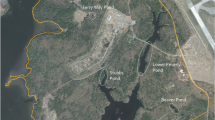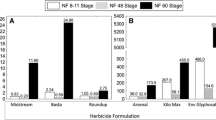Abstract
Teratogenesis, acute and chronic toxicity, growth and bioconcentration were investigated in various life stages (embryos, tadpoles, juveniles, adults) of the frogsXenopus laevis (African clawed frog),Rana catesbeiana (bullfrog) andRana pipiens (leopard frog) exposed to aqueous dieldrin in static-renewal and flow-through systems in a study on the development of wildlife-based water quality criteria.R. catesbeiana was the most sensitive tadpole in acute tests;X. laevis was the most sensitive in embryo-larval and chronic tadpole tests. Tadpole 96-h LC50s ranged from 40.4 to 49.5 μg/L dieldrin forX. laevis, from 8.7 to 30.3 μg/L forR. catesbeiana and was 71.3 μg/L forR. pipiens. The 24-day LC50 forX. laevis tadpoles was 5.5 μg/L dieldrin; the 28-day LC50 forR. pipiens tadpoles was 8.3 μg/L. AdultR. pipiens had a 28-day LC50 of 53.4 μg/L dieldrin. Gross spinal deformities in embryo-larval tests were observed at dieldrin concentrations as low as 1.3 μg/L after 10-days exposure toX. laevis and at 25.4 μg/L for a 21-day exposure toR. catesbeiana. MeanX. laevis 14 to 21-day LOAEL (Lowest Observed Adverse Effect Level) and NOAEL (No Observed Adverse Effect Level) values for embryo-larval tests (25.5 and 11.0 μg/L dieldrin, respectively) were virtually the same as the 21-day single test values obtained forR. catesbeiana (25.1 and 11.0 μg/L dieldrin). Mean 14 to 24-dayX. laevis LOAEL and NOAEL values for tadpole chronic tests (1.6 and <1.4 μg/L dieldrin, respectively) were lower than the 28-day single test values obtained forR. pipiens (4.1 and 1.9 μg/L, respectively).
Tissue dieldrin levels at the LC50, LOAEL and NOAEL in the tadpole acute tests were fairly similar betweenX. laevis (11, 24 and 7 μg/g, respectively) andR. catesbeiana (means of 8.6, 12.0 and 1.2 μg/g, respectively). In the tadpole chronic tests, dieldrin tissue concentrations were even closer for these parameters forX. laevis (1.8, 1.5 and 0.8 μg/g, respectively) andR. pipiens (1.7, 0.6 and 0.4 μg/g, respectively). Mean steady-state bioconcentration factors (BCF) for tadpoles (whole body) ranged from 430 forX. laevis, and from 540 to 1,130 forR. pipiens. Mean steadystate BCFs for adultR. pipiens skin, muscle and liver ranged from 40 to 310. The relative similarity of response to dieldrin betweenX. laevis and the two ranid species in this study demonstrates its usefulness in assessing potential environmental hazards. The current dieldrin water quality criterion of 0.0019 μg/L appears protective of frogs.
Similar content being viewed by others
References
Akkermans LMA, van den Bercken J, Versluijs-Helder M (1975a) Comparative effects of DDT, allethrin, dieldrin and aldrintransdiol on sense organs ofXenopus laevis. Pestic Biochem Physiol 5:451–457
Akkermans LMA, van den Bercken J, Versluijs-Helder M (1975b) Excitatory and depressant effects of dieldrin and aldrintransdiol in the spinal cord of the toad (Xenopus laevis). Eur J Pharmacol 34:133–142
Akkermans LMA, van den Bercken J, van der Zalm JM, van Straaten HWM (1974) Effects of dieldrin (HEOD) and some of its metabolites on synaptic transmission in the frog motor endplate. Pestic Biochem Physiol 4:313–324
American Society for Testing and Materials (1980) Standard practice for conducting acute tests with fishes, macroinvertebrates and amphibians. ASTM E729-80. Philadelphia, PA
-(1984) Proposed new standard practice for conducting bioconcentration tests with fishes and saltwater bivalve molluscs. Draft No. 8, E47.01. Philadelphia, PA
-(1991) Standard guide for conducting the frog embryo teratogenesis assay-Xenopus (FETAX). ASTM Z-1324. Philadelphia, PA
Anciaux H (1952) Study of the metabolism of lipides of the frog with the aid of C14. Verhandel Koninkl Vlaam Acad Wetenschap Belg Kl Wetenschap 14:5–20
Beiswenger RE (1988) Integrating anuran amphibian species into environmental assessment programs. U.S. Forest Service. Gen Tech Rep RM-166:159–165
Brockelman WY (1969) An analysis of density effects and predation inBufo americanus. Ecology 50:632–644
Brooks JA (1981) Otolith abnormalities inLimnodynastes tasmaniensis tadpoles after embryonic exposure to the pesticide dieldrin. Environ Pollut Ser A 25:19–25
Brown GW (1964) The metabolism of amphibia. In: Moore JA (ed) Physiology of the Amphibia. Academic Press, NY, pp 1–98
Calef GW (1973) Natural mortality of tadpoles in a population ofRana aurora. Ecology 54:741–758
Computer Sciences Corporation (1988) User's guide for a computer program for Dunnett's procedure in the analysis of data from short term chronic toxicity tests with aquatic organisms. U.S. Environmental Protection Agency, Cincinnati, OH
Cooke AS (1972) The effects of DDT, dieldrin and 2,4-D on amphibian spawn and tadpoles. Environ Pollut 3:51–68
Cooke AJ (1979) The influence of rearing density on the subsequent response to DDT dosing for tadpoles of the frogRana temporaria. Bull Environ Toxicol 21:837–841
Davies RP, Dobbs AJ (1984) The predicon of bioconcentration in fish. Water Res 18:1253–1262
de Llamas MC, de Castro AC, Pechen de D'Angelo AM (1985) Cholinesterase activities in developing amphibian embryos following exposure to the insecticides dieldrin and malathion. Arch Environ Contam Toxicol 14:161–166
Dial NA, Bauer CA (1984) Teratogenic and lethal effects of paraquat on developing frog embryos (Rana pipiens). Bull Environ Contam Toxicol 33:592–597
Garton RR (1980) A simple continuous-flow toxicant delivery system. Water Res 14:227–230
Greenhouse G (1976) The evaluation of toxic effects of chemicals in fresh water by using frog embryos and larvae. Environ Pollut 11:303–315
Hall RJ, Kolbe E (1980) Bioconcentration of organophosphorus pesticides to hazardous levels by amphibians. J Toxicol Environ Health 6:853–860
Hall RJ, Swineford D (1980) Toxic effects of endrin and toxaphene on the southern leopard frogRana sphenocephala. Environ Pollut Ser A 23:53–65
Hamiliton MA, Russo RC, Thurston RV (1977) Trimmed Spearman-Karber method for estimating median lethal concentrations in toxicity bioassays. Environ Sci Technol 11:714–719. Correction 12:417 (1978)
Henderson JE, Peyton GR, Glaze WH (1977) A convenient liquid-liquid extraction method for the determination of halomethanes in water at the parts-per-billion level. In: Keith LH (ed) Identification and analysis of organic pollutants in water. Ann Arbor Science, Ann Arbor, MI, pp 105–111
Kaiser TO, Dunham J (1972) The absorption of chlorinated hydrocarbon insecticides by frog skin. Proc Iowa Acad Sci 79:101–104
Kaplan HM, Overpeck JC (1964) Toxicity of halogenated hydrocarbon insecticides for the frog,Rana pipiens. Herpetologia 20:163–169
Korschgen LJ (1970) Soil-food-chain-pesticide wildlife relationships in aldrin-treated fields. J Wildl Manage 34:186–199
Lande SP, Guttman SI (1973) The effects of copper sulfate on the growth and mortality rate ofRana pipiens tadpoles. Herpetologica 29:22–27
Mayer FL, Ellersieck MR (1986) Manual of acute toxicity: Interpretation and data base for 410 chemicals and 66 species of freshwater animals. Resource Publication 160. U.S. Dept. Interior. Fish and Wildlife Service. Washington, DC
Meeks RL (1968) The accumulation of36Cl ring-labeled DDT in a freshwater marsh. J Wildl Manage 32:376–398
Nebeker AV, Griffis WL, Stutzman TW, Schuytema GS, Carey LA, Sherer SM (1991) Effects of dieldrin in continuous-flow water and in food on survival, growth and bioconcentration in young mallard ducks. Environ Toxicol Chem (in review)
New DAT (1966) The culture of vertebrate embryos. Academic Press, NY
Niethammer KR, White DH, Baskett TS, Sayre MW (1984) Presence and biomagnification of organochlorine chemical residues in oxbow lakes of northeastern Louisiana. Arch Environ Contam Toxicol 13:63–74
Petranka JW (1989) Chemical interference competition in tadpoles: Does it occur outside laboratory aquaria? Copeia 1989:921–930
Powell GVN, De Weese LR, Lamont TG (1982) A field evaluation of frogs as a potential source of secondary organophosphorus insecticide poisoning. Can J Zool 60:2233–2235
Rugh R (1962) Experimental embryology. Burgess Publishing Co., Minneapolis MN
Sanders HO (1970) Pesticide toxicities to tadpoles of the western chorus frogPseudacris triseriata and Fowler's toadBufo woodhousi fowleri. Copeia 2:246–251
Stephan CE, Mount DJ, Hansen DJ, Gentile JH, Chapman GA, Brungs WA (1985) Guidelines for deriving numerical national water quality criteria for the protection of aquatic organisms and their uses. U.S. Environmental Protection Agency. Office of Research and Development. Washington, DC NTIS PB85-227049
Surova GS (1988) Interactions of brown frog larvae in natural conditions. Ekologiya 4:49–54 (Translation)
U.S. Environmental Protection Agency (1979) Methods for chemical analysis of water and wastes. EPA-600/4-79-020. Environmental Monitoring and Support Laboratory, Cincinnati, OH
— (1980) Ambient water quality criteria for aldrin/dieldrin. EPA 440/5-80-019. Office of Water Regulations and Standards. Criteria and Standards Division, Washington, DC
Webb GD, Sharp RW, Feldman JD (1979) Effect of insecticides on the short-circuit current and resistance of isolated frog skin. Pestic Biochem Physiol 10:23–30
Williams B, Marcy S, Gerould S (1989) Water quality to protect wildlife resources. EPA 600/3-89-067. U.S Environmental Protection Agency. Corvallis Environmental Research Laboratory, Corvallis, OR
Williams S (ed) (1984) Official methods of analysis of the Association of Official Analytical Chemists, 14th ed. Association of Official Analytical Chemists, Arlington, VA
Author information
Authors and Affiliations
Rights and permissions
About this article
Cite this article
Schuytema, G.S., Nebeker, A.V., Griffis, W.L. et al. Teratogenesis, toxicity, and bioconcentration in frogs exposed to dieldrin. Arch. Environ. Contam. Toxicol. 21, 332–350 (1991). https://doi.org/10.1007/BF01060354
Received:
Issue Date:
DOI: https://doi.org/10.1007/BF01060354




